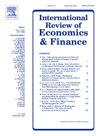How do carbon markets interact with energy-intensive sectors? Evidence from price connectedness
IF 4.8
2区 经济学
Q1 BUSINESS, FINANCE
引用次数: 0
Abstract
Reconciling economic development and emission reductions of polluting gases requires balancing long-term and short-term targets across various markets. As a new production cost, carbon price is expected to affect the supply and demand of energy-intensive sectors. Therefore, within a unified time-frequency framework, this study examines the dynamic connectedness between the largest carbon emission market (i.e., China) and energy-intensive sectors. Based on the daily trading price and trading volume of the national carbon market and eight carbon pilots, this study constructs a monthly China Carbon Market Price Indicator, and then measures the dynamic short- and long-term total and directional connectedness between the carbon market and six energy-intensive sectors. The empirical results show that the total connectedness is strong, particularly in the long-term. Nevertheless, the carbon market does not play an important role in the system, reflecting that China's carbon market is not mature, and the connection with other markets is relatively weak. Generally, the carbon market mainly receives information shocks from energy-intensive sectors rather than transmitting information to them. The carbon market does produce significant impacts on the construction and petroleum industries, particularly since 2021. Policy changes and major events drive changes in the connectedness between carbon markets and energy-intensive sectors. Therefore, balancing industrial developments and stable carbon prices requires refined policy designs accounting for diversified impacts of carbon markets on different sectors.
求助全文
约1分钟内获得全文
求助全文
来源期刊
CiteScore
7.30
自引率
2.20%
发文量
253
期刊介绍:
The International Review of Economics & Finance (IREF) is a scholarly journal devoted to the publication of high quality theoretical and empirical articles in all areas of international economics, macroeconomics and financial economics. Contributions that facilitate the communications between the real and the financial sectors of the economy are of particular interest.

 求助内容:
求助内容: 应助结果提醒方式:
应助结果提醒方式:


